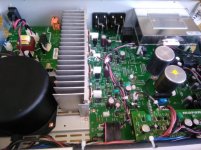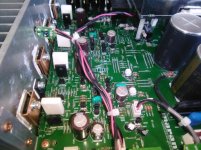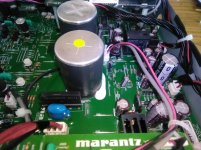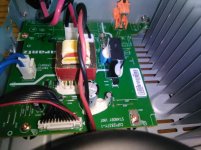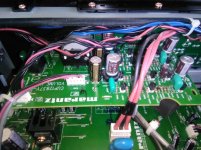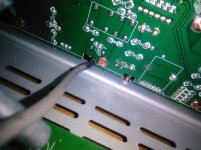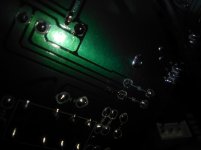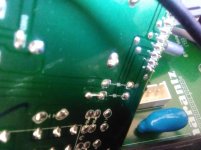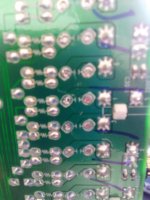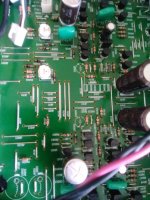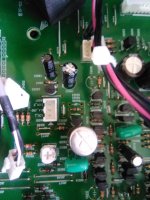Hi, my friends brother bought a new PM6006 and played it for a few months until renovating his house so he stored it away for about 12 months. He's tried to set it up again and the amp has a blinking red standby light and is in protection.
He didn't want to send off for the warranty of the unit after the sale and wanted me to have a look at it.
He says he hasn't shorted the speaker terminals, played it hard before and unplugged the units before undoing any wires etc.
I've noticed the little flap on the optical output is missing and a lot of what looks like loft insulation sitting on the circuit boards inside and nothing visible signs of a fault.
What is strange is as I tried to get some voltage measurements. I got a little shock from the top of the rear panel chassis, which leads me to think something is shorted to the chassis' ground.
Has anyone experienced something like this before?
He didn't want to send off for the warranty of the unit after the sale and wanted me to have a look at it.
He says he hasn't shorted the speaker terminals, played it hard before and unplugged the units before undoing any wires etc.
I've noticed the little flap on the optical output is missing and a lot of what looks like loft insulation sitting on the circuit boards inside and nothing visible signs of a fault.
What is strange is as I tried to get some voltage measurements. I got a little shock from the top of the rear panel chassis, which leads me to think something is shorted to the chassis' ground.
Has anyone experienced something like this before?
Attachments
If there had been a bit more visual evidence you could blame it on mice but I can see how he wouldn't want to claim warranty on it as a small piece is missing .
If its the UK then it would be an uphill job to get the repair done free as time and time again posters with all sorts of domestic equipment were knocked back by companies if even the hint of abuse/ self repair etc is found .
Very first test would be a check to see if its AC mains voltage , use your multi-meter to check that to a proven mains earth , if not then it could be DC but many of the repairs I have done in the past with "live " chassis equipment ( getting a shock from the casing ) involved AC .
Its possible than even a new electronic item stored away for a year that uses capacitors develops a leakage
To try to help those people on my previous website I read the companies small print and there are a long list of disclaimers built in.
If its the UK then it would be an uphill job to get the repair done free as time and time again posters with all sorts of domestic equipment were knocked back by companies if even the hint of abuse/ self repair etc is found .
Very first test would be a check to see if its AC mains voltage , use your multi-meter to check that to a proven mains earth , if not then it could be DC but many of the repairs I have done in the past with "live " chassis equipment ( getting a shock from the casing ) involved AC .
Its possible than even a new electronic item stored away for a year that uses capacitors develops a leakage
To try to help those people on my previous website I read the companies small print and there are a long list of disclaimers built in.
Thanks again for sharing your advice Duncan, much appreciated.
It's strange to me that when I touch the chassis with my fingertips, I got no little shock. Yet where the hairs on my skin is, like my wrist, I get a little shock. Feels only like a very small voltage shock.
I measured the chassis. My DMM has a 1.5VAC minimum setting. Showing zero VAC (0.00) on all voltage settings. DC goes from zero and then when I move my wrist very close to the chassis the reading jumps around from 27mV and -27mV. It's seems like it's static or something so I grounded myself and it's still the same.
Very interesting information about the capacitors.
All I've tested so far is the semiconductors with the unit unplugged and all measure fine.
I'll have to start pulling the boards out and checking underneath. I was thinking something conductive dropped in it but can't find nothing
It's strange to me that when I touch the chassis with my fingertips, I got no little shock. Yet where the hairs on my skin is, like my wrist, I get a little shock. Feels only like a very small voltage shock.
I measured the chassis. My DMM has a 1.5VAC minimum setting. Showing zero VAC (0.00) on all voltage settings. DC goes from zero and then when I move my wrist very close to the chassis the reading jumps around from 27mV and -27mV. It's seems like it's static or something so I grounded myself and it's still the same.
Very interesting information about the capacitors.
All I've tested so far is the semiconductors with the unit unplugged and all measure fine.
I'll have to start pulling the boards out and checking underneath. I was thinking something conductive dropped in it but can't find nothing
A bit of afterthoughts here?
Shoddy soldering that looks worse than the photos.
1st picture is on the front board, tone controls
2nd is on the volume unit board. Which is just links, not resistors as the board says. No continuity on the bottom link which has a solder pad missing
Shoddy soldering that looks worse than the photos.
1st picture is on the front board, tone controls
2nd is on the volume unit board. Which is just links, not resistors as the board says. No continuity on the bottom link which has a solder pad missing
Yes Stewart not the best mass production equipment used in their factory ,leaving ends sticking out can cause future shorts and due to the length of the component legs act like a "heatsink " and can cause HR soldering.
I notice Marantz has a warning at the start of the schematic that before sending it back to the factory for repair an insulation check must be made via a leakage current check of not more than 500microamps ( 0.5ma) or ohms test each leg of the power cord which should be MORE than 460 Kohms from each leg to chassis ----- this warning makes me wonder --.
I notice Marantz has a warning at the start of the schematic that before sending it back to the factory for repair an insulation check must be made via a leakage current check of not more than 500microamps ( 0.5ma) or ohms test each leg of the power cord which should be MORE than 460 Kohms from each leg to chassis ----- this warning makes me wonder --.
I notice Marantz has a warning at the start of the schematic that before sending it back to the factory for repair an insulation check must be made via a leakage current check of not more than 500microamps ( 0.5ma) or ohms test each leg of the power cord which should be MORE than 460 Kohms from each leg to chassis ----- this warning makes me wonder --.
Thats just a standard hi-pot test which is described in most service manuals
Is the grey cord in post 5 resting on the metal of the back plate perchance the mains cord for a cooling fan. There appears to be some damage from some unknown cause where this disappears under a cut out in the circuit board. There could be some chassis leakage current if the insulation is compromised.
I have had that experience with an underground water pump. Measuring with a normal meter revealed nothing so I called an electrician who had the right equipment for this job.
The leakage current may be small but enough to enter the earth of the nfb decoupling to earth which is an input. I think you could find there is dc on the outputs and why the protection circuit has activated.
If there is a child in the home that could account for the damage to the optical connectors - not a "biggie" to fix. As an infant I looked for "the man" in my parents 5 valve mantel radio and with my finger made a hole in the grille cloth and speaker cone.
There could be some claim on insurance if the "tingle" damage is extensive
I have had that experience with an underground water pump. Measuring with a normal meter revealed nothing so I called an electrician who had the right equipment for this job.
The leakage current may be small but enough to enter the earth of the nfb decoupling to earth which is an input. I think you could find there is dc on the outputs and why the protection circuit has activated.
If there is a child in the home that could account for the damage to the optical connectors - not a "biggie" to fix. As an infant I looked for "the man" in my parents 5 valve mantel radio and with my finger made a hole in the grille cloth and speaker cone.
There could be some claim on insurance if the "tingle" damage is extensive
Thanks for all your inputs, well appreciated.
The grey wire does appear a little stressed yet it hasn't opened the insulation yet well spotted.
I'm guessing you mean U8101&102 the +&- 15v regulators and yes I'm getting the correct voltages on the outputs before the protection turns the amp into standby.
I got an update the owner. He said he had some damp proofing work done on his house so he but the amp back in it's original box and left it in the spare bedroom. He lives on his own and he assures me nobody has touched it in the nine months it was there.
I have since removed the faceplate and it's circuit boards to check for any shorts. Nothing out of the ordinary so I assembled everything together. Powered it on and it was doing the same issues.
I have now removed the rear panel and pulled the main board out.
The ground plates that surrounds the RCA connections goes to the circuit board, not sure what they're called, but the solder joints have a ring around the leg of plates. I'll reflow those.
What does puzzle me is it only has the mylar caps on the 'Recorder' outputs and of course the phono stage. The 'tuner, CD, network' inputs caps look like they have been removed has the pads have solder surrounding the holes. I wondering if this is anything to do with the chassis issue.
Also the resistor (R6003) appears to of been removed too.
I understand circuits do change for a number of reasons yet does seem strange. Especially after I've just found a factory returned Denon AV amp resistor wasn't soldered in properly having one leg hanging out on the standby board
The grey wire does appear a little stressed yet it hasn't opened the insulation yet well spotted.
I'm guessing you mean U8101&102 the +&- 15v regulators and yes I'm getting the correct voltages on the outputs before the protection turns the amp into standby.
I got an update the owner. He said he had some damp proofing work done on his house so he but the amp back in it's original box and left it in the spare bedroom. He lives on his own and he assures me nobody has touched it in the nine months it was there.
I have since removed the faceplate and it's circuit boards to check for any shorts. Nothing out of the ordinary so I assembled everything together. Powered it on and it was doing the same issues.
I have now removed the rear panel and pulled the main board out.
The ground plates that surrounds the RCA connections goes to the circuit board, not sure what they're called, but the solder joints have a ring around the leg of plates. I'll reflow those.
What does puzzle me is it only has the mylar caps on the 'Recorder' outputs and of course the phono stage. The 'tuner, CD, network' inputs caps look like they have been removed has the pads have solder surrounding the holes. I wondering if this is anything to do with the chassis issue.
Also the resistor (R6003) appears to of been removed too.
I understand circuits do change for a number of reasons yet does seem strange. Especially after I've just found a factory returned Denon AV amp resistor wasn't soldered in properly having one leg hanging out on the standby board
Stewart I presume you have the service manual,
Marantz PM6006 Stereo Integrated Amplifier Manual | HiFi Engine
It provides the details for the protect _1 and protect_2 signals.
You should be able to find which one is causing the protection circuit to operate.
The DC power supply voltages are monitored hence why I asked you to check the plus and minus 15 volt supply rails, are all the other DC power supply voltages correct.
Also check if there is high DC on either output channels.
Marantz PM6006 Stereo Integrated Amplifier Manual | HiFi Engine
It provides the details for the protect _1 and protect_2 signals.
You should be able to find which one is causing the protection circuit to operate.
The DC power supply voltages are monitored hence why I asked you to check the plus and minus 15 volt supply rails, are all the other DC power supply voltages correct.
Also check if there is high DC on either output channels.
Thanks again Audio Service.
I was going through the service manual Briefly before making the post to get some voltage references until I noticed the buzz on the chassis.
Admittedly, I got side tracked from studying it properly. I'll go through it well over the weekend. Thanks for pointing out the protection signals.
I was going through the service manual Briefly before making the post to get some voltage references until I noticed the buzz on the chassis.
Admittedly, I got side tracked from studying it properly. I'll go through it well over the weekend. Thanks for pointing out the protection signals.
- Status
- This old topic is closed. If you want to reopen this topic, contact a moderator using the "Report Post" button.
- Home
- Amplifiers
- Solid State
- Marantz PM6006 Flashing standby light after storage
